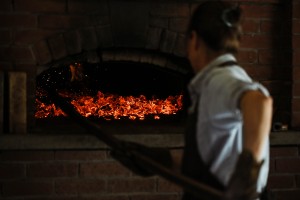We make our bread the same way people have been baking since the first leavened breads. Our loaves get their rise from natural leavening, and we mix them by hand. We bake them in a traditional wood-fired brick oven, building a fire on the hearth, then sweeping it out and baking the bread on the same surface.
We have fun developing new recipes, experimenting with old world grains like spelt, and trying to replicate modern classics. Some of these use more recent techniques, like adding a bit of commercial yeast to boost low-gluten flours or other dampening ingredients. Our ultimate goal is to bake breads that we love to eat, and that we feel comfortable feeding to our families and our community.
Baking is both a science and an art. Some bakers carefully measure and control temperature, protein levels, hydration, and other salient factors. Others rely entirely on instinct, developed over years of baking. We combine the two approaches, controlling what we can and adjusting to the rest based on our sense of what the bread needs at each stage.
 The Oven
The Oven
Our oven is a heavy mass of brick, designed to hold heat for a long period of time. It takes up about a third of the floor space in the bakery, and keeps the room comfortably warm days after it’s been fired. It’s a good size for our bakery – we can fit about 30 hearth loaves or 80 pan loaves in one load.
The day before a bake, we light a fire in the oven, feed it wood until it is roaring hot, and then shut it down the evening to evenly distribute the heat overnight. In the morning we sweep out the ashes and swab down the hearth. By noon, it’s cooled to 600° F or so. At this temperature, we can put four or five loads of bread through successfully.
Our oven was built by Pat Manley of Brick Stove Works in 2006. You can see the process here.
The Leavening
We use natural leavening in our breads, maintaining a sourdough starter we use to leaven each batch. The day before we bake we build up a small amount of the starter by feeding it flour and water in incremental amounts until we have the amount necessary for the bake size. Building the leavening fresh gives the bread a milder flavor than many sourdoughs, and strengthens its ability to rise the bread.
And Finally, The Bread
We mix our bread by hand in small batches in bins, starting early in the morning. Instead of kneading, we “turn” the dough, folding it over itself a number of times as it rises for two or three hours, which achieves the same effect and saves our wrists.
After we weigh and shape them by hand, the loaves rise for another few hours in steel loaf pans, wicker baskets, or on linen cloths, depending on the variety and our customer orders. We use wooden peels to load them into the oven, where they bake for 30 minutes to an hour, depending on the oven temperature.
When we take the bread out, we let it cool before we package and deliver it. Bread continues to develop after it’s taken out of the oven, and some say it isn’t finished until it is cool. As it cools on racks, you can hear the bread crackle as the crisp crust turns chewy, and the crumb becomes firm and moist.
